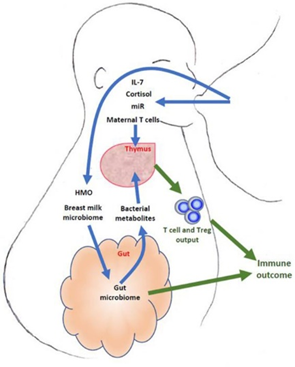Breast Feeding Resources

Cold and flu season are well upon us. Many mothers wonder if it is still safe for them to breastfeed if they are sick. Please assure them it is! In fact, breast milk contains multiple bioactive components that support the infant immune system:
· Immunoglobulins/antibiodies
o Breast milk is full of antibodies that are directed against the microbes the mother has been exposed to and protect the infant against a wide range of microorganisms.
o These include immunoglobulins A, G, M, D, and E, with SIgA being the most abundant. IgA promotes infant immune tolerance by coating the mucosal surfaces in the infant’s gut and reinforces its epithelial barrier to block pathogens, prevent inflammation, and stimulate the infant’s production of SIgA.
· Lysozymes
o Active against inflammation, and highest in the milk after 6 months. Lysozymes are not destroyed by heat treatment.
· Lactoferrin
o An antimicrobial, modulator of immune function. Lactoferrin may modify immune function through a lactoferring receptor in the intestine. It is able to suppress E.coli in the intestine.
· Maternal leukocytes
o “Hematopoietic-derived cells from breast milk survive the infant gastrointestinal tract… likely due to the weak digestive enzyme activities and low acidity of the infant stomach… This allows for the survival of maternal milk leukocytes.” FMI: Transfer of maternal immune cells by breastfeeding: maternal cytotoxic T lymphocytes
· Infant microbiome components:
o Human milk oligosaccharides (HMO): these protect against mucosal infections by regulating the gut epithelium, immune cells and microorganism.
o “Breast milk develops a supportive and protective microbiota. Glycosylated proteins such as lactoferrin, lysozyme, and immunoglobulins are important nonnutritive factors that protect infants from infection and, as a result, affect the development of the intestinal microbiome. These bioactive proteins are the first line of defense against potential pathogens within the infant gut and exert their protective effects via multiple and often overlapping mechanisms. These may have either direct or indirect effects on the intestinal microbiome by interacting with bacteria, engaging in pathogen destruction/deflection including immune exclusion, interacting with the infant mucosal immune system, and stimulating epithelial barrier function.” FMI: https://www.ncbi.nlm.nih.gov/pmc/articles/PMC4686345/pdf/nmi-suppl.1-2015-001.pdf
· Immune cells: Macrophages, granulocytes (neutrophils, etc.), leukocytes, lymphocytes: specifically, T-cells
o Thymic development
§ Previous research shows that the thymic index of breastfed infants is larger than formula fed infants, and that breastfeeding may influence the T cell compartment in infants.
§ “Breast milk may potentially modulate infant thymic development by influencing infant microbiome composition and bacterial metabolite production.”
§ “Cytokines, hormones, micro-RNAs, oligosaccharides, as well as active maternal immune cells and mammary microbiome may modulate the infant immune development through mechanisms both dependent and independent of the thymus.”
o Copyright © 2018 Hsu and Nanan
· And have you heard about HAMLET- human alpha-lactalbumin made lethal to tumor cells? HAMLET is a protein-lipid complex that induces apoptosis-like death in tumor cells, but leaves fully differentiated cells unaffected. HAMLET inactivates 40 forms of tumors. “This mechanism may contribute to the protective effect of breastfeeding against childhood tumors.”
There are rare contraindications to providing breast milk to infants. Read more here.
References :
Cabinian A, Sinsimer D, Tang M, Zumba O, Mehta H, Toma A, et al. (2016) Transfer of Maternal Immune Cells by Breastfeeding: Maternal Cytotoxic T Lymphocytes Present in Breast Milk Localize in the Peyer’s Patches of the Nursed Infant. PLoS ONE 11 (6): e0156762. doi:10.1371/journal.pone.0156762
Campbell SH, Lauwers J, Mannel R, Spencer B. Core curriculum for interdisciplinary lactation care. Burlington, MA: Jones & Bartlett Learning; 2019.
O’Sullivan et al. The Influence of Early Infant-Feeding Practices on the Intestinal Microbiome and Body Composition in Infants. Nutrition and Metabolic Insights 2015:8(S1) 1–9 doi:10.4137/NMI.S29530.

